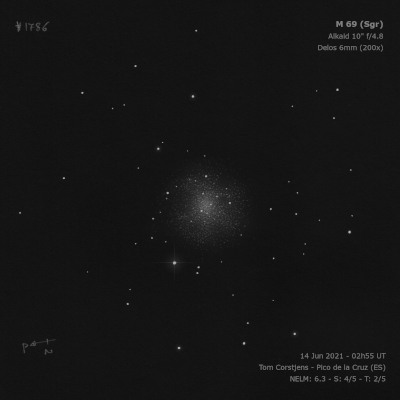
15x50mm IS binoculars (8/3/11): small, fairly faint glow. The mag 7.9 star 4.5' NW was cleanly resolved from the globular.
Charles Messier discovered M69 = NGC 6637 = D 613 = h3747 on 31 Aug 1780 and described "a nebula without star in Sagittarius... Near to it is a 9 mag star; the light is very faint; can be seen only in a good sky, and the least illumination of the micrometer wires extinguishes it... This nebula has been observed by M. de Lacaille and reported in his catalogue. It resembles the nucleus of a little comet. Diam. 2'." Glen Cozens states that Messier mistakenly assumed Lac I-11 referred to M69 and Lacaille's object is more likely just an asterism. See NGC 6634 or more.
William Herschel observed M69 in 1784 and noted "Very bright, pretty large, easily resolvable, or rather an already resolved cluster of minute stars. It is a miniature of the 53d of the Connoissance [M53]." James Dunlop observed it 4 times and described "a pretty bright round well-defined nebula, about 1 1/4' diameter, gradually condensed to the centre; there is a small star about 1' south of the nebula." John Herschel made 3 observations from the Cape of Good Hope. On 1 Aug 1834, he logged "globular, B, R, vgbM, resolved into stars 14..15m, diam 10 seconds in RA." Two nights later he noted "globular, pB, R, 3' diam, stars 14..15m." Christian Peters reported finding it around 1850 in Naples (AJ 2, 1856) and claimed it do not appear in any of his books.
200/250mm - 8" fairly bright, bright core, lively halo, few stars at edges, difficult to achieve resolution.
400/500mm - 17.5" (7/29/92): M69 is bright, moderately large, 3' diameter, round, fairly symmetric appearance with a large core surrounded by a small halo. A bright mag 12.5 star is embedded in the core or it contains a bright stellar nucleus. Several easy mag 13.3-14.0 stars were resolved around the edges of the halo and 15-20 very faint mag 14-15 stars were resolved in the halo with averted vision. Additionally, a few stars are also detected over the core. This is a very pretty globular with averted vision. Located 4.5' SE of mag 7.9 SAO 21059.
Notes by Steve Gottlieb